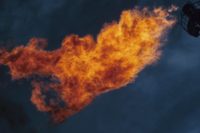Safer technology needed
Chairperson Moure-Eraso said, “We need a national mandate for state and federal regulators to require chemical facilities utilize inherently safer technology to the greatest extent practicable. For example, storing or utilizing less hazardous materials, making the process safer by lowering temperatures and pressures, and installing the most reliable equipment available are critical to lowering the industry’s accident rate.”
The report stresses that the accident occurred during a startup of the naphtha hydrotreater unit, considered hazardous non-routine work, particularly due to the reoccurring leaks of flammable liquid. Despite this, required Process Hazard Analyses (PHA) at the refinery repeatedly failed to ensure that these hazards were controlled and that the number of workers exposed to these hazards was minimized. In addition, past PHA’s, including those done by the preceding owner, Shell Anacortes Refining Company, cited only judgment-based safeguards and did not verify whether safeguards listed in the PHA’s were actually effective.
Proof of danger, rather than safery, was the requirement
Data for actual operating conditions was not readily available and technical experts were not required to prove safety effectiveness. “The refinery process safety culture required proof of danger rather than proof of effective safety implementation,” the report concluded.
As with the Chevron accident investigation, the Tesoro report notes the “considerable frequency of significant and deadly incidents at refineries over the last decade.” It states that in 2012 alone, the CSB tracked 125 significant incidents at U.S petroleum refineries. The draft report examines the effectiveness of refinery and chemical facility regulatory oversight, noting that Washington State’s Department of Labor and Industries (L&I) does not have sufficient personnel resources to verify that process safety management requirements are being implemented adequately. The report states that the agency audited the Tesoro refinery in March 2009 but found no deficiencies related to the heat exchanger that ruptured.
The regulatory findings in the report also concluded that under the existing U.S. and Washington State regulatory systems, there is no requirement to reduce risks to a specific target, for example as low as reasonably practicable, or ALARP, which is a hallmark of the safety case regime adopted successfully in Europe and Australia in the refinery and chemical sectors, as well as the nuclear and space sectors in the U.S. The safety case model is the subject of the draft regulatory report on the Chevron accident, released on December 16 of last year. The draft is still being considered by the Board.
Regulators must be independent
The draft report states in one of its 40 key findings: “It is essential that regulators of high-hazard facilities are independent, well-funded, well-staffed, and technically qualified. These individuals must be able to effectively communicate with refinery personnel and monitor the adequacy of refinery process safety practices.”
The draft report – subject to a future vote by the board – includes numerous proposed safety recommendations to Washington’s legislature and governor, to its regulatory agency, Tesoro, and the American Petroleum Institute. These include a recommendation to the state to establish a more rigorous regulatory model, possibly based on the safety case regime, revise the state’s process safety management regulations to ensure the prevention of catastrophic releases, perform a safety verification audit at all refineries in the state.
EPA should enforce IST
The report found that both the Tesoro and Chevron incidents could have been prevented if inherently safer equipment materials of construction had been used. Although the use of inherently safer technology (IST) is the most effective approach to preventing major chemical accidents, it is not enforced by the EPA through the General Duty Clause or EPA’s Risk Management Program. The report concludes that EPA has the authority to require the use of IST and recommends that it should do so.
Other proposed recommendations would urge API to clearly establish the minimum necessary “shall” requirements to prevent HTHA equipment failures. Recommendations to Tesoro were aimed among other things at revising and improving its Process Hazard Analysis and damage mechanism hazard review programs for all Tesoro refineries in order to validate damage mechanism hazards and safeguards. The company was also urged in the draft to implement a program to perform periodic process safety culture surveys among the work force at the Tesoro Anacortes refinery to be conducted by a third party.
The CSB is an independent federal agency charged with investigating industrial chemical accidents. The agency's board members are appointed by the president and confirmed by the Senate. CSB investigations look into all aspects of chemical accidents, including physical causes such as equipment failure as well as inadequacies in regulations, industry standards, and safety management systems.
The draft report is available at www.csb.gov for public comment until Sunday, March 16, 2014. Comments should be sent to tesorocomments@csb.gov. All comments received will be reviewed and published on the CSB website.


